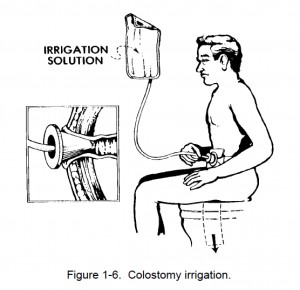a. Irrigation should be done at the same time each day in order to establish regularity of bowel evacuation.
Unless contraindicated or otherwise ordered by the physician, it is best to establish a routine of daily irrigation in accordance with the patient’s former bowel habits. For example, if the patient has always moved his bowels after breakfast, establish the irrigation routine for that time, rather than some other arbitrary schedule.
b. Review the procedure with the patient, if necessary.
c. Wash your hands.
d. Assemble the necessary equipment (Equipment can be kept at the patient’s bedside or in the bathroom.)
(1) Irrigation kit (irrigation bag with clamp and tubing, cone-tip irrigation catheter, irrigation drain pouch).
(2) Water soluble lubricant.
(3) IV pole (or other suspending hook).
(4) Soap and water.
(5) Washcloth and towel.
(6) Ostomy appliance.
(7) Waste receptacle.
(8) Prescribed irrigating solution, usually 500-1000cc warm (100º–105ºF) tap water.
e. Provide for privacy.
f. If the patient is ambulatory, have the patient sit on the toilet or on a chair facing the toilet. If the patient is bedridden, elevate the HOBº 45-90ºand position Chux around the patient.
g. Fill the irrigation bag with the prescribed solution and hang it on the IV pole or hook.
(1) The bottom of the bag should be at the patient’s shoulder level when he is seated to prevent fluid from entering the bowel too rapidly.
(2) The bottom of the bag should be placed 18 to 20 inches above the stoma when the patient is in bed.
h. Open the clamp on the irrigation tubing and allow the solution to fill the tubing. Reclamp. (This prevents the administration of air into the intestines.)
i. As necessary, prepare to begin the colostomy irrigation (see figure 1-6).
(1) Remove the ostomy pouch, if applicable, and place the irrigation drain pouch over the stoma. (Attach stoma belt if required.)
(2) Place the bottom, open end of the irrigation drain pouch in the toilet (or bedpan) to facilitate drainage by gravity.
(3) Connect the cone-tip catheter to the tubing and flush with solution.

Figure 1-6. Colostomy irrigation.
j. Lubricate the cone with the water-soluble lubricant to avoid irritating the mucous membranes.
k. Gently insert the cone into the stoma so that the stoma is occluded.
l. Unclamp the irrigating tubing and allow the water to flow in slowly.
(1) Allow water to enter the colon over a period of 10 to 15 minutes.
(2) If cramping occurs, slow down the flow rate and ask patient to deep breathe until cramps subside. Cramping during irrigation may indicate that:
(a) The bowel is ready to empty.
(b) The water is too cold.
(c) The flow is too fast.
(d) The tube contains air.
m. Clamp the catheter and remove from the stoma. Fold down the top opening of the irrigation drain pouch and secure it in the closed position.
n. Have the colostomy patient sit on or near the toilet for about 15 to 20 minutes so the initial colostomy returns can drain into the toilet. (If the patient is on bed rest, allow the colostomy to drain into the bedpan.)
o. Close the colostomy irrigation drain pouch with a rubber band or pouch clip, then ambulate the patient, or return him/her to bed.
(1) Ambulating stimulates elimination, producing improved irrigation return.
(2) Have the non-ambulatory patient lean forward or massage his/her abdomen to stimulate return.
p. Wait approximately 1 hour for the rest of the colostomy return, then remove the irrigation drain pouch from the patient.
q. Gently clean the area around the stoma with mild soap and water.
(1) Be careful not to rub the skin.
(2) Rinse and dry the area with a towel.
r. Apply a clean pouch or dressing, as applicable.
s. Provide for the patient’s comfort; remove and dispose of used supplies.
t. Record the procedure and significant nursing observations in the patient’s clinical record and report it to charge nurse.
(1) Note color and condition of stoma and peristomal skin.
(2) Record color, consistency, and amount of drainage.
(3) Note amount of irrigating solution used.
u. As recovery progresses, the nursing personnel should gradually assume a more passive role in colostomy care, allowing the patient to assume the active role.
